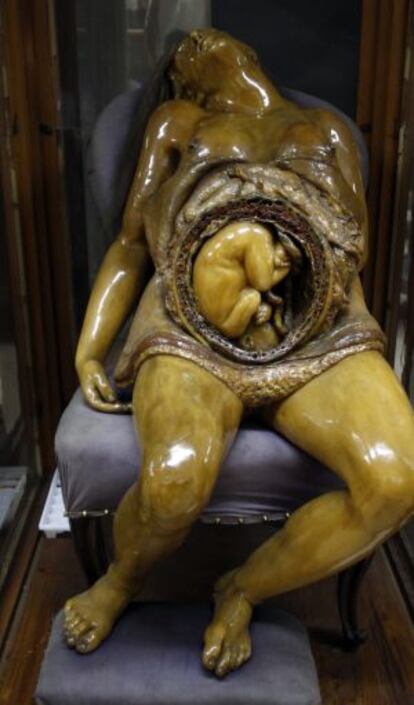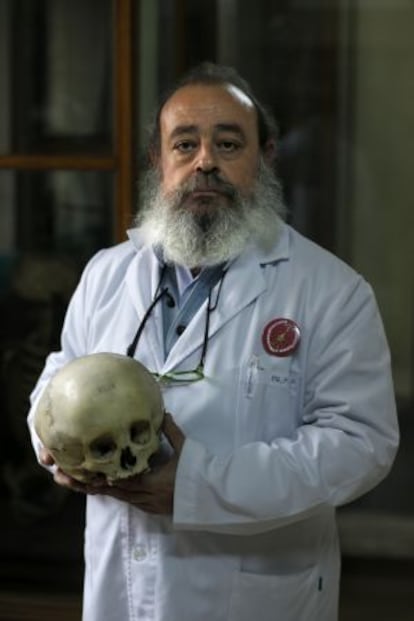A mother’s 200-year-old gift to anatomy
Madrid university aims to bring grisly wax models to a wider audience


The woman in labor has no name. She must have had one at some point, but as bad luck would have it, she was hit and killed by a carriage as she walked in front of the San Carlos Royal College of Surgery, back in 18th-century Madrid.
Nobody claimed the body, whose round belly contained a child about to be born. It was quite a windfall for the surgeons in training at the school, which was always short of corpses on which to learn anatomy.
The body handlers proceeded according to customs of the era: mud was applied and a mold created; this mold was filled with wax, and today it remains the most striking sculpture of those at the Complutense University School of Medicine. She is a Pietá lying back against a chair with her belly sliced open like a pomegranate and the fetus exposed, its little head pointing down. She is a life-like, life-size wax statue.
Museums like this one, filled with realistic sculptures that fuse art and pedagogics, exist in places like Florence (La Specola) and London (King's College), but the one in Madrid contains pieces that make it unique. The works were discovered in the 1980s by Professor Javier Puerta, now deceased, in a dark corner of one of the medicine school's basements. Today they make up a spectacular collection of wax and plaster figures, plastinates, human skeletons and 2,000 skulls. For centuries they helped, and still do, with the teaching of human anatomy.
There are representations of skinned bodies for the study of muscles and joints, mummies with their hearts on the right side, bodies sliced in half to better show the tumors, hernias, lymph nodes and malformations within, like a pelvis with two penises. They were all immortalized thus to inure future doctors and surgeons to unpleasant surprises.

"Back when there were no computers, cameras or recorders, this was the only way apprentice surgeons had of getting training. Anatomy departments used to hire painters, sculptors and draftsmen, and their work had a significant educational value, but also an artistic one," explains Professor Fermín Viejo during a stroll down the halls of this museum.
The symbiosis between art and pedagogics was complete: Michelangelo used to perform human dissections, and perhaps his fabulous sculptures have a cadaveric origin, too.
There are a few other oddities here, like the skeleton of a soldier in Napoleon's army who used to cure his venereal diseases with mercury, as can be deducted from the darkness of his bones.
But it is the series of wax fetuses, and in general all figures made in this material, that comprise the most valuable part of the collection. Alicia Sánchez Ortiz, a fine arts professor, is in charge of them.
"Wax modeling goes as far back as Ancient Egypt, but in the Renaissance workshops the artists used it for their preliminary models," she explains. It was cheap material that helped make the leap from the 16th-century anatomical illustrations to three-dimensional sculptures.
Those artists did extraordinary work, reproducing on wax bodies the intricate network of blood vessels through the use of silk threads punctuated with little knots. Wax is not affected by moisture, but it is by temperature, and this room inside the Medical School registers sudden temperature changes. The ceilings are chipped from old leaks, and the window blinds are stuck. Nobody who wishes to speak with precision would call this a museum, given the conditions. Walking in here is like discovering a gruesome art salon that's been locked shut for a long time, and for that same reason there is a bit of magic in it, too.
But some people are quite unhappy about it, such as anatomy professor Teresa Vázquez, who, like Fermín Viejo, is working hard to pull this collection out of oblivion and show it to the wider public, like elsewhere in Europe. For now, they are showing it to school groups, letting people know about it through word of mouth.
There was a time when corpses were dissected in public, out on the street, and in the winter, naturally. Then art came to the rescue of anatomy students, and it was King Charles III who brought back the custom from Italy. Surgeons began training in royal colleges at Cádiz and Barcelona, which also had their anatomical figures until religion whisked them away from science and melted them down: street processions required lots of wax for the candles. In Madrid, miraculously, the sculptures were saved, and today we can still gape at the frozen pregnancy of that unfortunate, nameless woman, who was made immortal by sculptor Juan Cháez.
Tu suscripción se está usando en otro dispositivo
¿Quieres añadir otro usuario a tu suscripción?
Si continúas leyendo en este dispositivo, no se podrá leer en el otro.
FlechaTu suscripción se está usando en otro dispositivo y solo puedes acceder a EL PAÍS desde un dispositivo a la vez.
Si quieres compartir tu cuenta, cambia tu suscripción a la modalidad Premium, así podrás añadir otro usuario. Cada uno accederá con su propia cuenta de email, lo que os permitirá personalizar vuestra experiencia en EL PAÍS.
¿Tienes una suscripción de empresa? Accede aquí para contratar más cuentas.
En el caso de no saber quién está usando tu cuenta, te recomendamos cambiar tu contraseña aquí.
Si decides continuar compartiendo tu cuenta, este mensaje se mostrará en tu dispositivo y en el de la otra persona que está usando tu cuenta de forma indefinida, afectando a tu experiencia de lectura. Puedes consultar aquí los términos y condiciones de la suscripción digital.








































